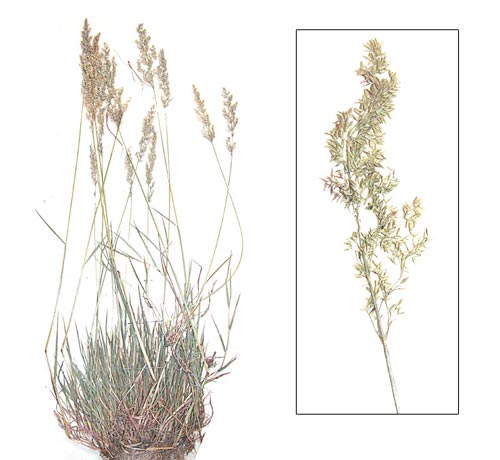Relatives
Agrostis stolonifera L. - Bentgrass.
Taxonomic position.
Family: Poaceae Barnhart, Genera: Agrostis L.Synonyms.
A. alba L. subsp. Stolonifera (L.) Jir., A. alba subsp. Stolonizans (Bess. Ex Schult. & Schult. Fil.) Lavr., A. jacutica Schischk., A. karsensis Litv., A. macrantha Schischk., A. palustris Huds., A. prorepens (Koch) Golub. Nom. illegit., A. pseudoalba Klok., A. sibirica V. Petrov, A. stolonifera subsp. palustris (Huds.) Tzvel., A. stolonifera subsp.stolonizans (Bess. Ex Schult. & Schult. fil.) Soo, A. Stolonizans Bess. Ex Schult. & Schult. fil., A. zerovii Klok.Morphology and biology.
It is a perennial grass. Height reaches 15(30) to 85 cm. It forms small swords with procumbent, plentiful leafy runners, lightly rooted (40 cm length, to 200 cm during floods). Roots reach down 6 cm into soil layer. Leaves are 3-10 cm in length, 2-4 mm in width, plain, thin, bright-green and numerous. Lingula of upper stem leaf is 2.5-3 mm long. Inflorescence is a narrow elongated panicle with short upright rough branches, (3)5 cm to 15 cm long. Panicle is compressed after flowering. Spikelet is 1.5-2.5 cm long. It has one flower, light-green or violet, with rough pedicel, usually without awn. Upper floral glume is shorter in size than lower one, and is shorter than glumes. Anther is about 1 mm in length and light-yellow. It is cross-pollinated and wind-pollinated. Seeds do not fall well. Mass of 1000 seeds is 0.09 g. Flowering occurs in June-August. Seed and vegetative are the predominant means of reproduction. Flowers are rarely produced, even under favorable conditions. Chromosome number 2n=28, 30, 33, 35, 40, 42.Distribution.
It grows in the European part of the former USSR (Eastern Europe), Caucasia, Western and Eastern Siberia (except Arctic part), Far East (invasion) and Middle Asia (north-eastern); Scandinavia, Atlantic and Middle Europe, Mediterranean, Asia Minor, Iran, Mongolia, Japan, China. Has been introduced to and invaded several other countries.Ecology.
It is a hydromesophite with a wide ecological range. Species occurs in meadows, mainly flood plains, damp, waterlogged meadows. It grows along pond banks, on river sands and shingle shelves, damp forest openings and mountainous zones. It inhabits areas near roads, villages and towns as a weed. Species prefers damp loam and clay soils, but it can grow on sandy soils, acidic and slightly saline soils. It is frost resistant, flood resistant (to 100 days), and saline resistant.Economic value.
Forage, for pasture use. It re-grows fast after intensive grazing; resistant to trampling and heavy feeding by cattle. It is decorative, used for establishing small recreation areas. It is enjoyed by cattle as food. It has potential as an erosion-preventing turf cover.Reference citations:
Cherepanov S.K. 1988. Plantae Vasculares Rossicae et Civitatum Collimitanearum (in limics USSR olim)[List of Vascular Plants of Russia]. St. Petersburg: Mir I Semia. 990 pp. (in Russian).Gubanov I.A., Kiseleva K.V., Novikov V.S., Tychomirov V.N. 2002. Illustrated determinant of plants of Middle Russia. Moscow: Partnership of Scientific Publications KMK, Institute of Technological Research Publisher. V. 1: 526 (in Russian).
Kharkevich S.S., ed. 1982. Wild fodder grasses of Far East. Moscow: Nauka. 240 pp. (in Russian).
Tzvelev N.N. 1976. Poaceae USSR. Leningrad: Nauka. 788 pp. (in Russian).


